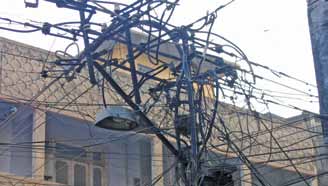“The smart grid is a new way to use a network to optimise the delivery of energy to consumers to manage efficiency, reduce cost and increase reliability,” adds Raina.
Miles to go
However, the mere availability of knowledge and products does not make the implementation of smart grids any easier in a country like India where the power sector is quite a mess. Several impediments lie along the way: inefficiency of the energy system, complex integration of alternative, distributed power sources; lack of common management, visibility and coordinated control; lack of reliability and resilience.
“Another problem in the implementation of smart grids in India is safeguarding our equipment from unsocial elements. Vandalism, sabotage of the system is common. Damaging the meters and other equipment provided on poles and transformers is not uncommon,” says Ramesh.
Possible, with commitment
The Indian government has realised this and taken a major step in the form of the Restructured Accelerated Power Development Reforms Programme (RAP-DRP), which aims to first clear up the existing system to make it amenable for smart grids and then implement smart grids. Various tasks under the programme include consumer indexing, GIS and asset mapping, metering of distribution transformers and feeders, automatic data logging, feeder segregation and ring fencing, IT applications for prompt response to consumer grievances, meter reading, billing and collection, energy audits and establishment of a base line data system. Other tasks include renovation, modernisation and strengthening of 11kV sub-stations, transformers and transformer centres, reconductoring of lines at the 11kV level and below, load bifurcation and balancing, strengthening at 33kV and 66kV levels, and installation of capacitor banks, mobile service centres, etc.

One step ahead, some smart grid pilots are under way in states like Maharashtra, Karnataka and New Delhi, in association with companies like Larsen & Toubro, Telvent, GE, Cisco, IBM and Tata Power.
The government has also launched a taskforce and a forum for smart grid development. The forum is a non-profit voluntary consortium of public and private stakeholders, research institutions and selected utilities with the objective of accelerating smart grid development in India, while the taskforce is going to be an inter-ministerial group to ensure awareness, coordination and integration of the diverse activities related to smart grid technologies, promotion of smart grid research and development, collaboration on interoperability framework and so on.
This is an overall sign of the country’s commitment towards the cause.
[stextbox id=”info” caption=”Some of India’s smart grid pilots”]
North Delhi Power Limited (NDPL) has implemented a smart grid project in association with Tata Power. It uses products such as GE’s PowerOn coupled with automatic metering infrastructure (AMI), and GE’ SmallWorld geographic information system. NDPL seems to have reduced losses from 54 to 18 per cent in the past few years.
Karnataka has planned a pilot at Bengaluru’s Electronic City. A budget of one billion rupees has been assigned, and the project plan was drafted in January this year. The implementation is expected to take two years.
Maharashtra has also planned a project with Larsen & Toubro and Telvent.
[/stextbox]
Smart Grids Need Smart Homes
Advanced metering infrastructure, smart meters and home area networking are all boring terms to describe what is actually an exciting technological effect—the smart home! Give consumers something like the intelligent in-home device that Intel showcased at the Consumer Electronics Show this year, and they will probably feel more compelled to participate in the smart grid revolution
The full benefits of a smart grid can be reaped only with the cooperation of the consumers. However, consumers are not going to do anything unless they get something in return. New technologies in the space promise to bridge this gap, with ‘smart’ products that will please both the consumer and the utility.
As we have discussed before, the smart grid is actually like a giant supply chain management system for the power sector—it links up the small and large suppliers, the distribution and transmission system, the utility and the consumers. Of these, proactive and cooperative consumers are very important for the success of this whole system. This is because managing technical faults and optimising stuff at the supplier and distributor end is only part of the story. Optimal power supply depends on optimal power consumption, that is, optimisation on the demand side—and this can be done only if the consumers are involved in the process.
Several methods are adopted by utilities in various countries (not many consumer-side measures exist in India, though) to manage the demand—differential pricing, smart meters and so on.
“Even whilst living in the arena of information, we only get to know about our energy consumption after we get the bill in our hands. We still have to place a phone call to the utility if a power failure or outage occurs, and it takes hours to identify and rectify the problem. What if we can govern our electricity bill just by changing the work hours of our appliance, or placing a networked sensor along wires which could locate and report a fault or prevent it from happening in the first place?” asks Priyanka Singh Panwar, senior hardware engineer, Powertech Automation Solutions, which manufactures remote monitoring and control systems.
For all this to happen, the smart grid should manifest in people’s homes too. Panwar explains that in people’s homes, the smart grid should mean detailed information through home energy-monitoring tools. These can be small displays or Web-based programs that give a real-time view of how much energy you are using, which appliances consume the most and how your home compares to others. Such information will give people ideas on how to cut energy bills.






